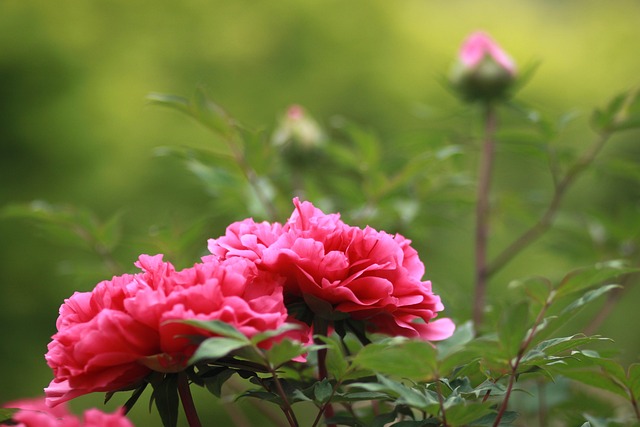Japanese tree peonies represent the perfect fusion of horticultural excellence and cultural significance, embodying centuries of Japanese aesthetic refinement and gardening mastery. These magnificent woody shrubs, known as “botan” in Japanese, are treasured not only for their spectacular blooms but also for their deep connection to Japanese culture and tradition.
The answer is simple: Japanese tree peonies are exceptional garden treasures that combine breathtaking beauty with remarkable longevity, offering gardeners both stunning spring displays and rich cultural heritage that spans over a millennium.
What Are Japanese Tree Peonies?
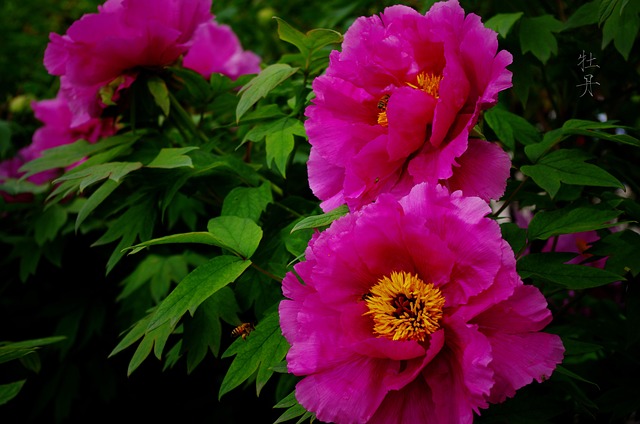
Japanese tree peonies are woody perennial shrubs that produce some of the largest and most spectacular flowers in the temperate garden. Unlike their herbaceous cousins that die back to the ground each winter, tree peonies maintain their woody structure year-round, growing larger and more impressive with each passing season.
Botanical Classification and Characteristics
Japanese tree peonies belong to the Paeonia × suffruticosa hybrid group, distinguished by several remarkable features:
- Size: Mature plants can reach 4-6 feet in height and spread
- Flowers: Blooms range from 6-10 inches in diameter
- Growth habit: Slow-growing, gaining only 1-6 inches annually
- Longevity: Can live for centuries with proper care
- Bloom time: Late April to early May in temperate zones
The flowers display an incredible range of forms, from simple single petals surrounding golden stamens to fully double, ruffled masterpieces that resemble silk peonies crafted by skilled artisans.
Japanese vs. Chinese Tree Peonies: Key Differences
| Characteristic | Japanese Tree Peonies | Chinese Tree Peonies |
|---|---|---|
| Flower Form | More open, upright growth | Wider variety of forms |
| Color Range | Pure, intense colors | More diverse palette |
| Growth Habit | Upright, architectural | Variable growth patterns |
| Fragrance | Generally fragrant | Mixed fragrance levels |
| Flower Size | Consistently large | Variable sizes |
The Rich Cultural Heritage of Japanese Tree Peonies
Historical Journey: From China to Japan
The story of Japanese tree peonies begins in 8th century CE, when Buddhist monks transported these precious plants from China to Japan. Initially valued for their medicinal properties rather than ornamental beauty, tree peonies gradually evolved to become symbols of nobility and refinement.
During the Edo period (1603-1868), tree peonies experienced unprecedented popularity, with Japanese horticulturalists developing unique cultivation techniques and breeding programs that created distinctly Japanese varieties.
Cultural Symbolism and Meaning
In Japanese culture, tree peonies carry profound symbolism:
- Honor and wealth: Known as the “king of flowers”
- Bravery and nobility: Associated with samurai virtues
- Good fortune: Planted for prosperity and blessing
- Fleeting beauty: Representing life’s precious, temporary nature
The aesthetic principle of “wabi-sabi” finds perfect expression in tree peonies, celebrating both peak beauty and graceful aging.
Tree Peonies in Japanese Art and Literature
Tree peonies have inspired countless works of Japanese art, from delicate woodblock prints to elaborate kimono designs. In classical Japanese poetry, they symbolize the ultimate expression of natural beauty, often appearing in haiku that capture moments of seasonal transformation.
Essential Growing Conditions
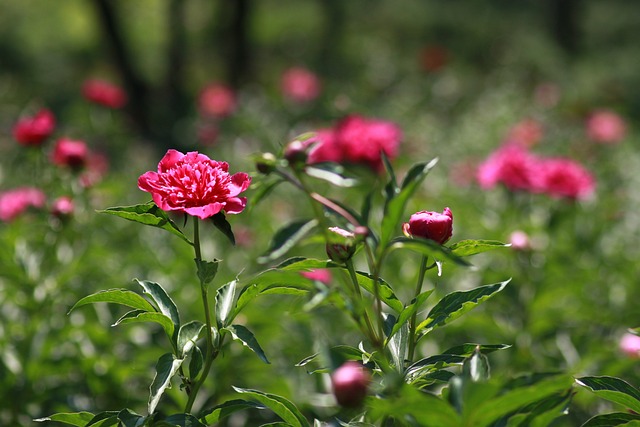
Creating the ideal environment is crucial for Japanese tree peony success. These plants have specific requirements that, when met, result in spectacular long-term performance.
Climate and Hardiness Zones
Japanese tree peonies thrive in USDA zones 4-8, requiring:
- Cold winter period: 30-45 days below 40°F for proper flower development
- Moderate summers: Protection from extreme heat beneficial
- Good air circulation: Prevents fungal diseases
- Wind protection: Shields delicate blooms from damage
Soil Requirements and Preparation
The foundation of successful tree peony cultivation lies in proper soil preparation:
Optimal soil conditions:
- pH level: 6.5-7.0 (neutral to slightly alkaline)
- Drainage: Excellent drainage absolutely essential
- Organic matter: Rich in compost and well-rotted manure
- Depth: Deep, well-cultivated soil to 18 inches
- Nutrients: Regular enrichment with organic materials
Poor drainage is the leading cause of tree peony failure. If your soil retains water, consider raised beds or extensive soil amendment with sand and organic matter.
Light and Location Considerations
Japanese tree peonies perform best with:
- Morning sun: Essential for healthy growth
- Afternoon shade: Protects flowers in hot climates
- Air circulation: Reduces disease pressure
- Stable location: Rarely transplant once established
- Root space: Away from competing large shrubs or trees
Planting Your Japanese Tree Peony
Proper planting technique determines long-term success. Take time with this crucial step, as tree peonies dislike disturbance once established.
When to Plant: Timing is Everything
Fall planting (September-November) provides optimal establishment:
- Allows root development before winter dormancy
- Plants emerge strong in spring
- Better survival rates than spring planting
- Cooler temperatures reduce transplant stress
Proper Planting Depth and Technique
Critical planting guidelines:
- Dig wide, deep hole: 18 inches wide and deep
- Check graft union: Look for swollen area on stem
- Plant deeply: Graft union 4-6 inches below soil surface
- Backfill carefully: Mix native soil with compost
- Water thoroughly: Deep initial watering, then moderate
Deep planting encourages the scion to develop its own roots, reducing dependence on the rootstock and improving long-term vigor.
Spacing and Garden Design Tips
Design considerations:
- Spacing: 5 feet between plants minimum
- Companion plants: Low perennials that don’t compete
- Background: Dark evergreens highlight flowers beautifully
- Access: Plan for viewing and photography paths
- Future growth: Consider 10-year mature size
Complete Care Guide
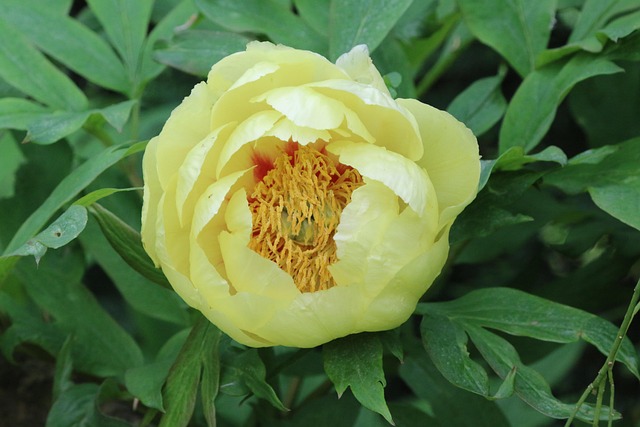
Japanese tree peonies are surprisingly low-maintenance once established, requiring primarily seasonal attention and basic cultural care.
Watering Requirements and Techniques
Watering best practices:
- First year: Regular deep watering for establishment
- Established plants: Generally drought-tolerant
- Avoid overwatering: Leading cause of root rot
- Morning watering: Allows foliage to dry
- Mulching: Conserves moisture and suppresses weeds
Water deeply but infrequently, allowing soil to dry slightly between waterings.
Fertilization Schedule and Best Practices
Seasonal feeding program:
Spring (Early March):
- Apply balanced granular fertilizer around base
- Add 2-3 inches fresh compost mulch
- Avoid fertilizer contact with stems
Fall (October):
- Phosphorus-rich fertilizer (bone meal excellent)
- Promotes strong root development
- Prepares plant for winter dormancy
Supplemental feeding:
- Mid-season foliar feed with fish emulsion
- Organic compost tea monthly during growing season
Pruning Guidelines for Optimal Growth
Essential pruning principles:
- Minimal pruning: Tree peonies require little cutting
- Timing: Early spring when buds visible
- Deadheading: Remove spent flowers to prevent seed formation
- Dead wood removal: Cut damaged branches to healthy tissue
- Shape pruning: Light shaping after flowering
Important note: Flower buds form in summer for next year’s display. Late-season pruning removes next year’s flowers.
Popular Japanese Tree Peony Varieties
The diversity of Japanese tree peony cultivars offers something for every garden preference and growing condition.
Classic Traditional Varieties
‘Hana Kisoi’ (Floral Rivalry)
- Large, cherry-pink ruffled flowers
- Strong stems hold blooms upright
- Reliable bloomer in northern climates
- Grows 4 feet tall, 3.5 feet wide
‘Godaishu’ (Five Continents)
- Pure white flowers up to 10 inches across
- Upright growth habit
- Outstanding fragrance
- Cold-hardy to zone 4
‘Shimane Sedai’
- Rose-colored semi-double flowers
- Ruffled petal edges
- Becomes more double with age
- Beautiful green foliage
Modern Hybrid Selections
‘Shima Nishiki’ (Fire Flame)
- Unique red and white striped petals
- Each flower displays different patterns
- Semi-double form with yellow centers
- Striking garden focal point
‘Kamada Fuji’
- Lavender-purple large blooms
- Clear, intense coloration
- Heavy fragrance
- Reliable spring performer
Common Problems and Solutions
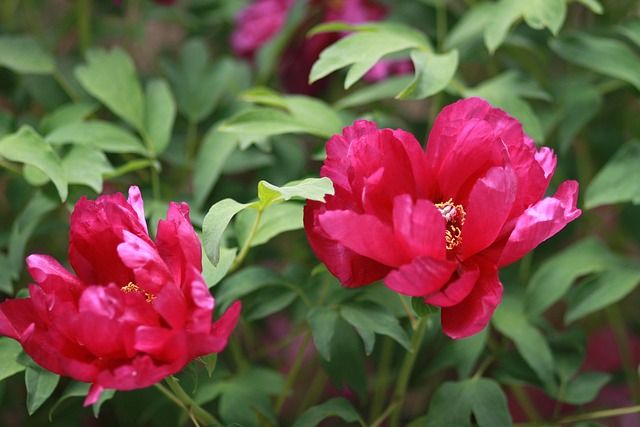
Understanding potential challenges helps maintain healthy plants and prevent serious issues.
Pest Management
Common pests and controls:
- Chafer beetles: Hand-picking or neem oil treatments
- Aphids: Beneficial insects and insecticidal soap
- Rabbits: Physical barriers around young plants
- Deer: Generally deer-resistant due to plant compounds
Prevention strategies:
- Encourage beneficial insect populations
- Remove plant debris to eliminate overwintering pests
- Maintain good garden hygiene
Disease Prevention and Treatment
Primary diseases:
Powdery Mildew:
- Symptoms: White powdery coating on leaves
- Prevention: Good air circulation, avoid overhead watering
- Treatment: Fungicidal soap sprays
Botrytis Blight:
- Symptoms: Brown, fuzzy mold on flowers and stems
- Prevention: Proper spacing, remove fallen petals
- Treatment: Improve drainage, fungicide if severe
Poor Flowering: Causes and Remedies
Common flowering problems:
| Problem | Cause | Solution |
|---|---|---|
| No flowers | Too young, planted too shallow | Wait for maturity, check planting depth |
| Buds don’t open | Late frost, stress factors | Protect from frost, improve care |
| Small flowers | Insufficient nutrients, water stress | Fertilize properly, maintain moisture |
| Short bloom period | Hot weather, poor location | Provide afternoon shade, mulch roots |
Enjoying Japanese Tree Peonies Year-Round
Maximize the garden value and cultural connection of these remarkable plants throughout the seasons.
Seasonal Care Calendar
Spring (March-May):
- Apply fertilizer and fresh mulch
- Monitor for pest emergence
- Enjoy spectacular blooming season
- Photograph peak displays
Summer (June-August):
- Deep watering during dry spells
- Deadhead spent flowers
- Monitor for diseases
- Plan garden improvements
Fall (September-November):
- Apply phosphorus fertilizer
- Plan and plant new trees
- Begin leaf cleanup
- Prepare for winter
Winter (December-February):
- Protect from harsh winds if needed
- Plan for next year’s garden additions
- Order new varieties
- Study plant structure without leaves
Cut Flower Arrangements
Japanese tree peonies make exceptional cut flowers:
- Harvest timing: Early morning when buds just opening
- Stem preparation: Cut at angle underwater
- Longevity: 5-7 days with proper care
- Arrangements: Combine with spring foliage and bulbs
Photography and Garden Design
Photography tips:
- Early morning light enhances flower colors
- Focus on individual blooms for detail shots
- Capture garden context with wider views
- Document seasonal progression
Garden design integration:
- Create seasonal succession with companion plants
- Use as specimen plants in mixed borders
- Underplant with spring bulbs and perennials
- Design viewing areas for peak bloom appreciation
Notable gardens to visit:
The Brooklyn Botanic Garden houses one of the finest Japanese tree peony collections in North America, featuring over 300 specimens representing 49 different varieties. This remarkable collection was gifted by the Japanese town of Yatsuka-Cho in 2002 as a memorial to the September 11 victims and serves as an outstanding example of international horticultural diplomacy.
Visitors to Brooklyn Botanic Garden often share their amazement on social media. One recent visitor posted: “The tree peonies at BBG are absolutely breathtaking! The size and fragrance of these blooms is unlike anything else in the spring garden. The pink varieties near the Japanese Hill-and-Pond Garden were particularly stunning this year.”
Summary
Japanese tree peonies offer the dedicated gardener an unparalleled combination of horticultural excellence and cultural richness. These remarkable plants reward patience and proper care with decades of increasingly spectacular spring displays, connecting us to centuries of Japanese garden tradition.
Key success factors include: proper site selection with excellent drainage, deep autumn planting, minimal but timely pruning, and understanding that these plants improve dramatically with age. The investment in time and careful cultivation yields gardens of extraordinary beauty that honor both the natural world and the refined aesthetic sensibilities of Japanese culture.
Whether you choose classic varieties like ‘Hana Kisoi’ or dramatic modern selections like ‘Shima Nishiki’, Japanese tree peonies will become treasured centerpieces of your spring garden, offering not just beautiful flowers but a living connection to one of the world’s great gardening traditions.
